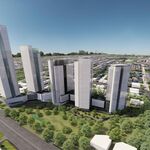wyliepoon
Senior Member
Link to article
Building on the past
The town by the lake looks to future
May 24, 2007 04:30 AM
San Grewal
STAFF REPORTER
Susan Crane arrived in this idyllic place on the lake 24 years ago and like many before and after her was drawn by Oakville's confident, small-town charm.
But as Oakville celebrates its 150th birthday, a lot of its residents wonder if that characteristic charm will endure the drastic changes taking place.
Others would like to see some of the changes happen faster.
Days before one of the largest towns in the country officially celebrates its anniversary, Crane sits in a park overlooking Oakville Harbour, where years ago she waited anxiously to hear if her husband had landed a job that would bring them here.
"I knew, almost immediately, that this was where I wanted to be.
"I had lived in Scarborough, Barrie, Brampton, Etobicoke and London. But Oakville had everything we wanted, it addressed all our needs."
With a current average household income of $130,000, Oakville continues to be one of the wealthiest municipalities in Canada, a status address sought out by Bay St. bigwigs and young professionals including, as of late, successful second and third generation immigrants of all stripes.
It is home to a vibrant downtown, some of the best private and public schools in the province, renowned recreational programs and an array of natural beauty: parks and greenbelts, watersheds connected by streams, Sixteen Mile Creek, Joshua Creek, Morrison Creek and the Trafalgar Moraine. And, of course, its lakeshore.
But the exclusive Camelot many residents are still fiercely protective of has recently been threatened by development that has already seen the population swell from 80,000 in 1984 to almost 180,000, and now includes plans for 55,000 more people.
"When we moved our home was in what was called north Oakville," says Crane, referring to the area just north of the QEW highway.
"Now it's mid-Oakville. Things just exploded in the '90s."
Through her community work as an employee of the Oakville Museum, she has her finger on the pulse of the town.
"A lot of people didn't like the growth that started in the '90s. There would be more traffic, more noise, more people. But ... how long could this last?"
Not everyone was that laissez-faire about the changes. With development now pushing up past Dundas St. and a proposal supported by the previous mayor to extend Oakville's northern boundary to Highway 407, residents struck back.
In last fall's election Ann Mulvale lost her job to current mayor Rob Burton, who promised not to succumb to the forces of development.
But with all the growth, changes for the better have also taken place.
"When we moved here 13 years ago, I knew Oakville was a predominantly white environment," says Hal Johnson, one half of the popular Body Break duo, along with his wife Joanne McLeod.
The couple were living in Mississauga, which was becoming too crowded and lacked Oakville's natural connection to its recreational/outdoor lifestyle.
Johnson, a natural athlete who played on Canada's national baseball team, is the son of an African-American father and an Irish-Canadian mother.
"We moved to Canada when I was an infant because my mother didn't want us living in the U.S. because of the racism."
As an adult, with a successful business and fatherhood in the not-too-distant future, Johnson thought Oakville was the perfect place to settle, despite its reputation as an upscale white enclave.
"Every time I drive down Kerr St., I think of what happened," he says, referring to a Ku Klux Klan rally on the downtown street in 1930 to oppose the marriage of a white woman to a black man.
He still wonders if his 8-year-old daughter would be more comfortable in a place with more diversity.
"It's getting a lot better in Oakville. But the changes I see in Toronto, where diversity is just a fact of life, aren't happening as fast in Oakville."
"But the area where I live (in north Oakville along 16 Mile Creek) is a lot more diverse than when we moved here."
He says it's been a natural evolution for successful young families from all backgrounds to seek out Oakville for its status, great schools and natural beauty.
"Now everyone is starting to feel more comfortable here. With our business we could live anywhere, but Oakville is where we choose to live."
Building on the past
The town by the lake looks to future
May 24, 2007 04:30 AM
San Grewal
STAFF REPORTER
Susan Crane arrived in this idyllic place on the lake 24 years ago and like many before and after her was drawn by Oakville's confident, small-town charm.
But as Oakville celebrates its 150th birthday, a lot of its residents wonder if that characteristic charm will endure the drastic changes taking place.
Others would like to see some of the changes happen faster.
Days before one of the largest towns in the country officially celebrates its anniversary, Crane sits in a park overlooking Oakville Harbour, where years ago she waited anxiously to hear if her husband had landed a job that would bring them here.
"I knew, almost immediately, that this was where I wanted to be.
"I had lived in Scarborough, Barrie, Brampton, Etobicoke and London. But Oakville had everything we wanted, it addressed all our needs."
With a current average household income of $130,000, Oakville continues to be one of the wealthiest municipalities in Canada, a status address sought out by Bay St. bigwigs and young professionals including, as of late, successful second and third generation immigrants of all stripes.
It is home to a vibrant downtown, some of the best private and public schools in the province, renowned recreational programs and an array of natural beauty: parks and greenbelts, watersheds connected by streams, Sixteen Mile Creek, Joshua Creek, Morrison Creek and the Trafalgar Moraine. And, of course, its lakeshore.
But the exclusive Camelot many residents are still fiercely protective of has recently been threatened by development that has already seen the population swell from 80,000 in 1984 to almost 180,000, and now includes plans for 55,000 more people.
"When we moved our home was in what was called north Oakville," says Crane, referring to the area just north of the QEW highway.
"Now it's mid-Oakville. Things just exploded in the '90s."
Through her community work as an employee of the Oakville Museum, she has her finger on the pulse of the town.
"A lot of people didn't like the growth that started in the '90s. There would be more traffic, more noise, more people. But ... how long could this last?"
Not everyone was that laissez-faire about the changes. With development now pushing up past Dundas St. and a proposal supported by the previous mayor to extend Oakville's northern boundary to Highway 407, residents struck back.
In last fall's election Ann Mulvale lost her job to current mayor Rob Burton, who promised not to succumb to the forces of development.
But with all the growth, changes for the better have also taken place.
"When we moved here 13 years ago, I knew Oakville was a predominantly white environment," says Hal Johnson, one half of the popular Body Break duo, along with his wife Joanne McLeod.
The couple were living in Mississauga, which was becoming too crowded and lacked Oakville's natural connection to its recreational/outdoor lifestyle.
Johnson, a natural athlete who played on Canada's national baseball team, is the son of an African-American father and an Irish-Canadian mother.
"We moved to Canada when I was an infant because my mother didn't want us living in the U.S. because of the racism."
As an adult, with a successful business and fatherhood in the not-too-distant future, Johnson thought Oakville was the perfect place to settle, despite its reputation as an upscale white enclave.
"Every time I drive down Kerr St., I think of what happened," he says, referring to a Ku Klux Klan rally on the downtown street in 1930 to oppose the marriage of a white woman to a black man.
He still wonders if his 8-year-old daughter would be more comfortable in a place with more diversity.
"It's getting a lot better in Oakville. But the changes I see in Toronto, where diversity is just a fact of life, aren't happening as fast in Oakville."
"But the area where I live (in north Oakville along 16 Mile Creek) is a lot more diverse than when we moved here."
He says it's been a natural evolution for successful young families from all backgrounds to seek out Oakville for its status, great schools and natural beauty.
"Now everyone is starting to feel more comfortable here. With our business we could live anywhere, but Oakville is where we choose to live."




